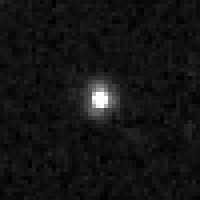(612584) 2003 QX113
 Hubble Space Telescope image of 2003 QX113 taken in 2006 | |
| Discovery[1][2] | |
|---|---|
| Discovered by | CFEPS[3]: 8 |
| Discovery site | Mauna Kea Obs. |
| Discovery date | 31 August 2003 |
| Designations | |
| 2003 QX113 | |
| L3q03[3] | |
| Orbital characteristics[4] | |
| Epoch 1 July 2021 (JD 2459396.5) | |
| Uncertainty parameter 2[1] · 3[4] | |
| Observation arc | 14.34 yr (5,236 d) |
| Aphelion | 62.238 AU |
| Perihelion | 37.674 AU |
| 49.956 AU | |
| Eccentricity | 0.2459 |
| 353.09 yr (128,966 d) | |
| 141.21° | |
| 0° 0m 10.08s / day | |
| Inclination | 6.7261° |
| 158.07° | |
| 26.381° | |
| Physical characteristics | |
| 423 km (est.)[5][8] | |
| 22.85[9] | |
| 5.1[1][4] | |
(612584) 2003 QX113 is a large trans-Neptunian object from the scattered disc located in the outermost region of the Solar System. It is one of the most distant objects from the Sun at 60.5 AU. It was discovered by astronomers with the Canada–France Ecliptic Plane Survey at Mauna Kea Observatories, Hawaii, when it was near aphelion on 31 August 2003. It was provisionally designated 2003 QX113.[1]
Orbit and classification
[edit]
2003 QX113 orbits the Sun at a distance of 37.7–62.2 AU once every 353 years and 1 month (128,966 days; semi-major axis of 49.96 AU). Its orbit has an eccentricity of 0.25 and an inclination of 7° with respect to the ecliptic.[4]
It is classified as a scattered disc object,[5] or "near-scattered" object in the classification of the Deep Ecliptic Survey,[7] that still gravitationally interacts with Neptune (30.1 AU) due to its relatively low perihelion of 37.7 AU, contrary to the extended-scattered/detached objects and sednoids which never approach Neptune as close. It has also been described as a "detached classical belt object" by the discovering Canada–France Ecliptic Plane Survey (CFEPS), that are objects with a semi-major axis beyond the 2:1 mean-motion resonance (i.e. beyond the twotino population at 47.8 AU) and with an eccentricity larger than 0.24.[3]: 4 It was furthest object discovered in CFEPS.[3]: 8
Most distant objects from the Sun
[edit]2003 QX113 last came to perihelion around 1882,[4] moving away from the Sun ever since and is currently about 60.5 AU from the Sun,[9] which is further away than the dwarf planet Sedna, and will reach its aphelion around 2058.[10] Its current distance makes it one of the most distant known minor planets in the Solar System (also see List of Solar System objects most distant from the Sun § Known distant objects).[11]
Physical characteristics
[edit]Based on a generic magnitude-to-diameter conversion, 2003 QX113 measures approximately 423 kilometers (260 miles) in diameter, for an assumed albedo of 0.9 and an magnitude of 5.1.[5][8] As of 2021[update], no rotational lightcurve for this object has been obtained from photometric observations. The body's rotation period, pole and shape remain unknown.[4]
See also
[edit]References
[edit]- ^ a b c d "2003 QX113". Minor Planet Center. Retrieved 8 September 2021.
- ^ "MPEC 2006-H29 : 45 NEW MULTIPLE-OPPOSITION TNOs". Minor Planet Electronic Circular. Minor Planet Center. 22 April 2006. Retrieved 8 September 2021.
- ^ a b c d Petit, J. -M.; Kavelaars, J. J.; Gladman, B. J.; Jones, R. L.; Parker, J. Wm.; Van Laerhoven, C.; et al. (October 2011). "The Canada-France Ecliptic Plane Survey—Full Data Release: The Orbital Structure of the Kuiper Belt". The Astronomical Journal. 142 (4): 131. arXiv:1108.4836. Bibcode:2011AJ....142..131P. doi:10.1088/0004-6256/142/4/131. ISSN 0004-6256. S2CID 250817604.
- ^ a b c d e f g "JPL Small-Body Database Browser: (2003 QX113)" (2017-10-23 last obs.). Jet Propulsion Laboratory. Retrieved 8 September 2021.
- ^ a b c d "List of Known Trans-Neptunian Objects". Johnston's Archive. 18 August 2020. Retrieved 8 September 2021.
- ^ "MPEC 2010-K70 : DISTANT MINOR PLANETS (2010 JUNE 13.0 TT)". Minor Planet Electronic Circular. Minor Planet Center. 29 May 2010. Retrieved 8 September 2021.
- ^ a b "Orbit Fit and Astrometric record for 03QX113". Southwest Research Institute. Retrieved 8 September 2021. (The Deep Ecliptic Survey Object Classifications)
- ^ a b "Asteroid Size Estimator". CNEOS NASA/JPL. Retrieved 8 September 2021.
- ^ a b "Asteroid 2014 SV349 – Ephemerides". AstDyS-2, Asteroids – Dynamic Site. Retrieved 8 September 2021.
- ^ "Horizon Online Ephemeris System". California Institute of Technology, Jet Propulsion Laboratory. Retrieved 8 September 2021.
- ^ "Observational Query: objects more than 57.0 AU from the Sun". AstDyS-2, Asteroids – Dynamic Site, Department of Mathematics, University of Pisa, Italy. Retrieved 8 September 2021.
External links
[edit]- List Of Centaurs and Scattered-Disk Objects, Minor Planet Center
- What is the most distant body in the Solar System? A historical view (Michael Richmond)
- (612584) 2003 QX113 at AstDyS-2, Asteroids—Dynamic Site
- (612584) 2003 QX113 at the JPL Small-Body Database


